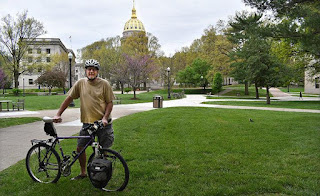Yesterday, I wrote about an effort to make Austin, Texas more bike- and pedestrian-friendly. I haven't been there, but if it's anything like the parts of the Lone Star State I've seen, the complaints of its cyclists and pedestrians don't surprise me: Even Houston, its biggest city (and the fourth-largest in the US) can seem like an expanse of auto-centric suburban sprawl, especially if you're accustomed to a city like mine (New York), Boston, San Francisco or most major European burgs, bourgs or bergs.
Then again, I have to admit I was a little bit surprised that, from what I was reading, bike lanes and sidewalks are so poorly conceived, designed or maintained--or nonexistent outside central parts of the city. After all, during the past three decades, many young, educated people--the ones who, during the same period, were most likely to become recreational or commuting cyclists--moved to the Lone Star Capital. And it has a major university, which usually is enough to ensure a significant number of cyclists.
Today I was reminded of another reason why one might expect Austin to be a better place for cyclists. Now, I know that almost anything that happened more than two years ago seems as distant as the Mesopotamian civilization but, believe it or not, three decades ago isn't so long in, as Doctor King said, the long arc of history.
Just as there was indeed a time before COVID-19, there was also a time when Lance Armstrong was a kind of "golden boy." He had just won the World Championship and was seen as an heir apparent to Greg LeMond and the generation of American riders who put their country on the sport's map for the first time in decades.
Well, back then, Lance lived in Austin. Professional cyclists are like other professional athletes in that they aren't "working" only when involved in a race, game or match. Having been a racer for very brief time in my life, I know that in order to be competitive, you have to pedal for a few hours every day. It's really as much of a commitment as going to the office, factory, school or wherever you make your living or forge your identity. In addition, most cyclists, as well as other athletes, spend considerable amounts of time in other kinds of conditioning, such as running or weight-lifting.
But one would think that with all of the cycling Lance--and, most likely, others--were doing, the city would have been more conscious of their needs. You see, not only was he seen as a "rising star;" he had yet to be tainted by accusations of drug use. In fact, he may not have been using any banned substances (at least, not in detectable quantities) in those days, before his cancer diagnosis. If you look at pre-illness photos of him and compare them to images of him after he returned to the sport, it's not difficult to believe as much.
Anyway, I couldn't help but to wonder whether Lance, had he retained his status, could have made a difference in hometown's cycle and pedestrian infrastructure. Maybe he could have. Then again, maybe he couldn't have: After all, aside from people who bought Trek bicycles in the US Postal Service Team colors, I'm not sure he influenced much else.
Still, it makes me feel old to think there was a time before COVID-19--and when Lance was revered.






